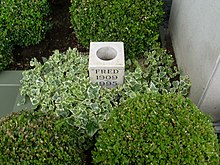Fred Perry
[5] But due to his disillusionment with the class-conscious nature of the Lawn Tennis Club of Great Britain, the working-class Perry turned professional at the end of the 1936 season and moved to the United States where he became a naturalised U.S. citizen in 1939.
[4][7] In 1984, a statue of Perry was unveiled at Wimbledon, and in the same year he became the only tennis player listed in a survey of 2,000 Britons to find the "Best of the Best" British sportsmen of the 20th century.
Perry moved to Brentham Garden Suburb in Ealing, west London aged eleven years when his father became the national secretary of the Co-operative Party after World War I.
"Perry took advantage of his athletic build and extraordinary physical capacity: he was highly mobile and fast, had a sound defence and placed his balls very well.
[9] At the Budapest World championships men's singles event, Perry beat Miklós Szabados 3 games to 1 to win the title.
He reached several quarter finals of tennis events in the London area at Herga club in Harrow, Blackheath, Fulham and Ealing.
[19] In August, Perry won the Eastern grasscourt championships in Rye, New York beating Cliff Sutter in the semis and J. Gilbert Hall in the final.
[32] In May, Perry won the British hard court championships in Bournemouth over Adrian Quist,[33] Lee[34] and Austin[35] in the final three rounds.
[37] In November, whilst touring Australia, Perry played in the Victorian championships in Melbourne and beat Harry Hopman and Jack Crawford to take the title.
Perry's success attracted the adoration of the crowds at Wimbledon particularly as he contrasted sharply with the privileged background of most patrons and players associated with the All England Club at the time.
Perry won "without going to the net more than a half dozen times in 50 games and when it was all over Budge had scored more points than his adversary, made fewer errors and many more placements".
1 amateur by A. Wallis Myers,[44] Pierre Gillou,[45] Bernard Brown,[46] John R. Tunis,[47] Bill Tilden,[48] Ned Potter,[49] G.H.
Cummings (The Courier Mail),[52] and J. Brookes Fenno, Jr.[53] (The Literary Digest) Perry beat Abel Kay in the final of the New Zealand championships in January.
Perry stayed close to the baseline save in the second set, for he saw that he could triumph without going to the net, thus exposing his wings to the German's favorite shot a razor-like drive down the sidelines.
Perry had learned from the Wimbledon masseur that von Cramm had suffered a groin strain which limited his ability to move wide on the forehand.
"Verging on victory, the pressure weighed heavily on the slightly built, elongated American, while Perry, an experienced campaigner, remained cool", according to Chicago Tribune.
[72] In the Davis Cup, Perry led the Great Britain team to four consecutive victories from 1933 to 1936, with wins over France in 1933, the United States in 1934 and 1935, and Australia in 1936.
[99] Soon after the pro circuit petered out in mid-1942, Perry was involved in World War 2, where he served in the U.S. Air force,[100] having already gained American citizenship in 1939.
On 2 February 1995, Perry died at Epworth Hospital in Melbourne, Australia, after breaking his ribs following a fall in a hotel bathroom.
Perry's final marriage to Barbara Riese (the sister of actress Patricia Roc) in 1952 lasted over forty years, until his death.
[117] In the late 1940s, Perry was approached by Tibby Wegner, an Austrian footballer who had invented an anti-perspirant device worn around the wrist.
[118] The brand was initially run by the Perry family, namely his son David, until it was bought by Japanese company Hit Union in 1995.
[123] Kings of the Court, a video-tape documentary made in 1997 in conjunction with the International Tennis Hall of Fame, named Perry one of the ten greatest players of all time.
In 100 Greatest of All Time, a 2012 television series broadcast by the Tennis Channel, Perry was ranked the 15th-greatest male player, just behind Boris Becker at 14th, and just ahead of Stefan Edberg at 16th.
Kramer says that Perry was "extremely fast; he had a hard body with sharp reflexes, and he could hit a forehand with a snap, slamming it on the rise—and even on the fastest grass.
He maintained that "there was never any easing up in his tour matches with Ellsworth Vines and Bill Tilden since there was the title of World Pro Champion at stake."
A bronze statue of Fred Perry was erected at the All England Lawn Tennis Club in Wimbledon, London, in 1984 to mark the 50th anniversary of his first singles championship.
The 14-mile (23 km) route from Woodford in the south to Reddish in the north, combines rural footpaths, quiet lanes and river valleys with urban landscapes and parklands.
[127] In June 2012, an English Heritage blue plaque was unveiled on the house at 223 Pitshanger Lane, Ealing, London, where Perry lived between 1919 and 1935.
[129] In the United States, two drives in El Paso, Texas, and Baton Rouge, Louisiana, and a street in Springfield, Tennessee, are named after Fred Perry.






